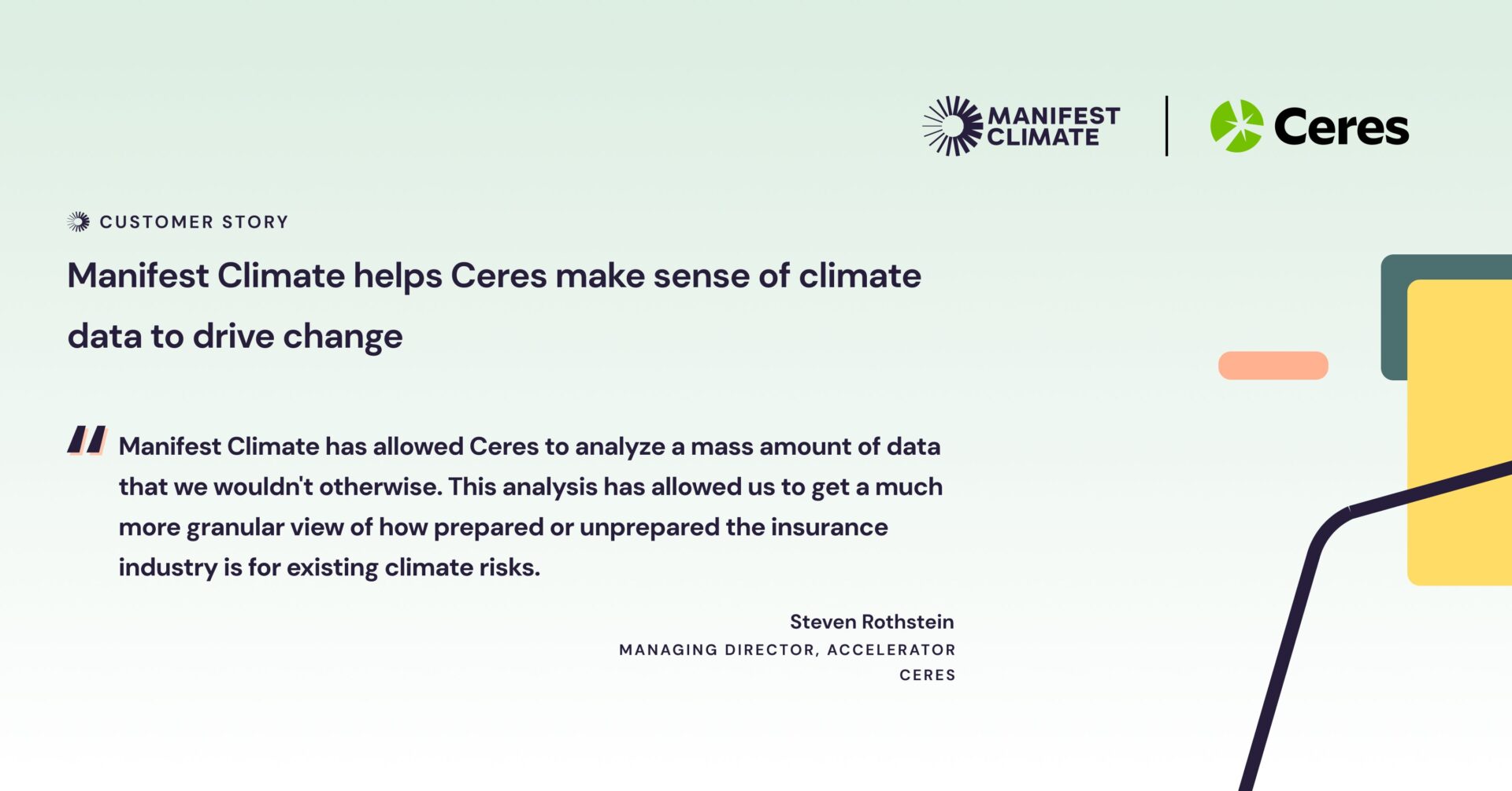Ceres Accelerator for Sustainable Capital Markets is a nonprofit advocacy organization working to accelerate the transition to a cleaner, more just, and sustainable economy. The organization works with companies, investors, policymakers and regulators to educate, advocate, and investigate opportunities and challenges in the net zero transition.
Ceres reached out to Manifest Climate for a unique task — to help them produce a comprehensive report on the state of TCFD disclosures in the insurance industry. But although the Ceres use case is unique, the underlying problem — too much data, not enough consistency — is one that is all-too familiar to sustainability, finance, risk, and consulting teams. The abundance of climate disclosures, each presented in varying formats, makes it challenging to determine a starting point or identify key areas for assessment.
How Ceres leverages Manifest Climate to turn data into insights
The team at Ceres believe that data is critical to the net zero transition. “You can’t manage a problem if you can’t measure it,” says Steven Rothstein, Managing Director, Accelerator at Ceres.
In 2022, the team launched a study of the insurance industry to assess how many insurance companies were disclosing climate plans based on the TCFD framework. “Knowing that regulation was coming, and that there would be a massive amount of information, we needed to ask: how do we evaluate all that information?” says Rothstein. “Manifest Climate’s platform has been a very effective tool to look at climate risk information from a high level. It was too much information to analyze without assistance.”
“And what would be heartbreaking is if you have all this information, and then you’re not able to use it,” Rothstein explains. “It’s too much. It’s not processed. It’s not easily comparable. It’s not in a format that the marketplace can begin to process.”
Why Manifest Climate?
It was Manifest Climate’s detailed breakdown of TCFD disclosures that attracted the Ceres team to the software. “That’s really the key,” says Rothstein — “to have not just machine learning, but machine learning that understands what the TCFD pillars are, the key risks, the importance of language like ‘metrics’ and ‘governance’ and ‘risk management’ and ‘strategies’ to help us evaluate thousands and thousands of data points.”
What would it look like without Manifest Climate?
For the Ceres team, it wasn’t a question of “do we need it?” but rather a question of “which solution suits us best?” Without a machine-learning-based tool to help them process and organize their data, the team would have had to resort to randomized sampling or produce a much less comprehensive industry report.
“Without Manifest Climate,” Rothstein explains, “we would not have been able to analyze TCFD reports for roughly 500 companies. This would have impacted the information available for regulators, insurers, and others in the marketplace.”
How would you describe Manifest Climate?
Manifest Climate’s software has allowed us to analyze a mass amount of data that we wouldn’t otherwise. This analysis has allowed us to get a much more granular view of how prepared or unprepared the insurance industry is for existing climate risks.
Steven Rothstein, Managing Director, Ceres Accelerator
Give your climate team a competitive edge with Manifest Climate
Manifest Climate is the leading Climate Intelligence Software that provides decision-makers with climate-related insights and recommendations to inform decisions, seize opportunities, and mitigate risk.
Manifest Climate uses industry-leading AI models to create comparability from qualitative climate information faster, more accurately, and more consistently than humans.
Issuers, service providers, and financial institutions choose Manifest Climate for ease of use, in-house climate expertise, and depth of qualitative climate data.
With Manifest Climate, teams reduce time spent on manual research by 99%, improving precision and consistency as a result.

